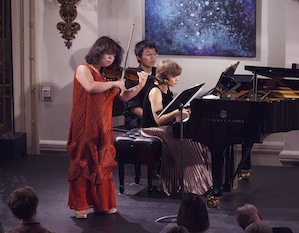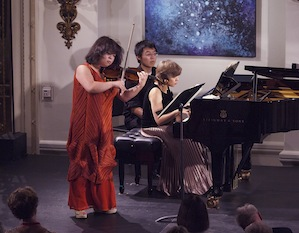
Music@Menlo’s Carte Blanche series allows artists to choose whatever they want to play. In these concerts, audiences are likely to discover pieces or even composers they have never heard of before. For her program on July 30, violinist Yura Lee chose five Eastern-European composers: Georges Enescu from Romania, Antonín Dvořák and his pupil Joseph Suk from the Czech culture, and Hungarians Béla Bartók and Jenő Hubay. All the selections were written between 1885 and 1940, yet even within this geographical and historical confine, there was plenty of musical variety.
I happened to visit Eastern Europe last summer, including some remote villages and Gypsy festivals in Romania, where I heard the authentic folk music of the region. I can report that most of the local folk music sounds and feels completely different from what these learned composers put down on paper. Bartók gets closest, for short spurts, before going off on crazy tangents. The other composers sounded more Western than Eastern. Just in the translation from free-style fiddling to music notation, many of the little nuances are lost. Trying to fit the music into neat, mathematical divisions of measures and time signatures constricts a lot of the freedom.
Furthermore, the folk violin technique is quite different, with left wrists bent and diagonal bow strokes (big no-no’s at the conservatory). Even their violins are different — and I got to try one: The strings were backward (G instead of E and vice versa), and everything was caked with a crusty layer of oily rosin.
Yura Lee is a world away from that. Her technique is immaculate, with bow strokes so supple that the bow direction changes are inaudible. Yet as she glides across the strings, she still manages to pull forth a dark and rich tone, especially in the lower register. Everything is so smooth in her playing, though, that there is not enough bite and articulation, so, consequently, the E-string sometimes doesn’t catch. Her control of the ultra-high register is astonishingly accurate. Her unison octaves are very well in tune. As for improvisatory spirit and “dirty” peasant-style fiddling, she left that for the Gypsies.
Her technique is immaculate, with bow strokes so supple that the bow direction changes are inaudible.
Ensecu’s Impressions d’enfance is a programmatic narrative of memories from childhood. It begins with a rather intense solo cadenza. At Music@Menlo, when the piano finally entered, Dina Vainshtein provided crystal-clear chords. Not once did she overpower the violin, instead playing out fully only when the violin rests. The bird call imitations in the middle section were enchanting, as were some sections where the piano and violin play a simple melody in unison. The obstinate coda at the end was extradramatic, extending the end further and further with huge chords (echoes of Beethoven and Satie?).
After Enescu’s free-ranging, Impressionist-style trip, Dvořák’s Romantic Pieces sounded very pleasing to the ear. The predictable A-B-A forms were at first comforting, but then became predictable. By contrast, Hubay’s Scenes de la csarda (Scenes from a tavern) was a classic Hungarian showpiece with a slow introduction leading to an outburst of klemzmer-like dance grooves and a virtuosic finale. Lee handled it all with perfect grace, as if she was playing Mozart. There were no crazy surprises in phrasing, no fun spontaneity; it was all very conservative and expertly executed.
Hubay’s Scenes de la csarda (Scenes from a tavern) was a classic Hungarian showpiece with a slow introduction leading to an outburst of klemzmer-like dance grooves and a virtuosic finale.
After intermission, Suk’s Four Pieces were a stepping stone to Bartók’s Sonata No. 1 for Violin and Piano (1921). Here, Lee finally truly let loose, as per the composer’s directions and his iconoclastic deviation from both Western harmony and style. The finale, with its gnarly, scratchy series of running fast notes, really brought back memories of the Romanian music festival I witnessed in Transylvania. Sometimes I wonder if Bartók’s written-in dissonances are his idea of a translation of the folk musicians’ intonation. Whatever he had in mind, Lee and Vainshtein rustled up intense sonorities and an energy that went above and beyond everything else on the program.
Following a rousing ovation, fired up by the festival’s enthusiastic students, the encore harked back to the 19th-century fantasy world of Dvořák’s Songs My Mother Taught Me.

